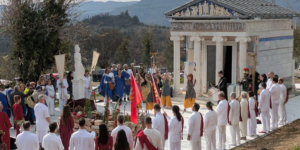“Golu” in Tamil, also known as Kolu, is a unique display of various dolls and figurines in odd numbered steps (“padis”). It is celebrated in this manner in the four southern states of India. These steps are covered with a white cloth and the dolls are arranged on it. The dolls are mostly of the gods and goddesses from Hinduism.
Arranging Navrathri Golu is an event in itself, for it means an occasion for neighbours, friends and other relatives to visit each others homes to view and admire the Navarathri Golu . Gifts are exchanged amongst women. Generally, it is a custom that women exchange coconuts, cloths and sweets. Sumangali (married) women also exchange bags containing a small mirror, turmeric, comb, beetle leaves with supari (beetle nuts).This is also the time when women who sing well, sing songs in praise of the Goddesses Durga, Sarawati and Lakshmi.
The 9th day of Navratri is the day of Saraswati where special pujas are offered to Goddess- representing wisdom and enlightenment. All things of art and learning, books, instruments and creativity are placed in the puja and worshipped. Work tools and instruments are also worshipped and this is known as Ayudha puja. All types of ‘vahanas’ –vehicles–also have a special puja.
The 10th day is known “Vijayadasami” – and considered most auspicious because this is when evil was destroyed by good. It represents new beginning and heralds prosperity. It is an extremely auspicious day to start new ventures. Children often start classes on this day. Students who want to learn new things join classes on this day. Books and musical instruments are taken out to be read and practice, so that the whole year they excel at the studies started on this auspicious day. People in industry start using their tools and machinery with same positive attitude.
On the 10th night after the ceremonial arti and prayers, the dolls are laid down to sleep. The next morning, they are wrapped carefully in cloth or paper and preserved for use the next year. Another novel trend is the concept of `community kolus’, when many women, unable to keep kolu in their homes, join hands and put up a Navratri kolu in a common place.
Every year, some enthusiastic people may buy a few new dolls to add to their collection, others may just keep the old sets, which they have had for generations. Decorations also vary, some are very elaborate, where they would build displays of mountains,rivers, lake, garden, parks etc. with all kinds of colourful lights, making their Golu really stand out where as some houses may have a very simple and traditional display of dolls.

This nine-day festival of Navaratri in Hindu religion is held in honour of the nine manifestations of Goddess. Navratri literally means nine nights and is celebrated differently in different regions of India and marks the arrival of winter season. Every day a dish called Sundal is made as an offering to the Goddess and the dolls. This Sundal is made from different lentils like chickpeas, yellow peas, black-eyed beans and so on, with coconut gratings, green chillies, flavoured with salt, asafoetida, lemon juice, and some fresh curry leaves and fresh coriander, and sometimes if available also with a dash of raw mangoes. This is a very tasty, highly nutritious dish, which is enjoyed by everyone.
Like most festivals in India, there is a deep connection with agriculture in the Golu Navaratri. The significance of clay being given a godly form is seen in many parts of India, almost always with agrarian symbolism.
Source

































